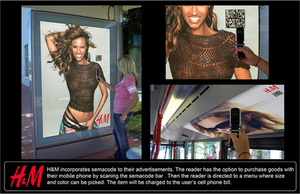
- Food and Lodging Recommendations – This is probably the most obvious application, as you are in a single physical location so you are most likely to agree to receive information for places to stay (if you are looking) or a good restaurant to eat at. Any restaurant guide service like Zagats could easily use this as a promotion to share their content.
- Personal Homing Beacons – Who hasn’t been stuck in a new location and unable to describe your location to someone else who is trying to make their way there? Street intersections are good, but sometimes that is not descriptive enough. Imagine semacode lamp posts where you could snap a photo and essentially create a homing beacon for yourself for anyone to find you. You could help your friend with no sense of direction find you through Google maps on their phone, or more usefully, order a Domino’s pizza straight to the middle of nowhere.
- Scavenger Hunt Style Promotions – As these rise in popularity, using semacodes imprinted onto locations or objects could enable a really fun chain reaction game where you find one clue and get a message telling you about the next one. These would be indecipherable to people who do not know what they are, but provide essential clues to game participants. For more interaction, a brand could even let people generate their own and generate clues for others.
- HyperLocal Town/Suburb Info Guides – Walking into a new city with a Lonely Planet guide is great, but in smaller areas or suburbs, the infornation is often very little for travellers. Semacodes printed into public spaces could bridge this gap by offering a way for local citizens to contribute content online and share information about destinations and attractions that no tourism book would likely cover. Think more broadly about this, and it’s easy to see how semacode marketing could reinvent how small towns or even suburbs market their localities as tourism destinations.
I am sure there are lots more possibilities for using semacodes – especially as camera phones become more common and people get more sophisticated about how they use their mobile devices to access timely and relevant information. I will definitely be watching this space.
About the Idea Bar: Working in a creative team, the life of our business is new ideas. We come up with them every day for clients, but sometimes there are ideas that just don’t fit a client. They are too big, too different, or just not quite right. Inspired by John at Digital Influence Mapping Project, the IdeaBar is a category of posts that are meant to be "open source" and offer new ideas for marketing. Take them and use them … all I ask for is a link back to this post if you find these ideas useful and talk about them. Read more IdeaBar posts on this blog.






WE RECENTLY REMOVED COMMENTING - LEARN WHY HERE >